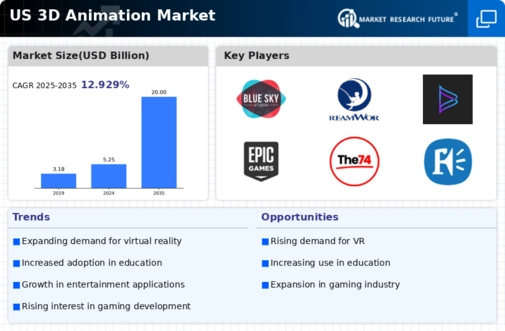The competitive landscape of the US 3D Animation Market is characterized by dynamic shifts and a constant evolution of technologies, creativity, and consumer preferences. As the market progresses, various companies are vying to capture consumer attention through innovative animated content. The industry is influenced by factors such as advancements in computer graphics, growing demand for high-quality animation in entertainment, advertising, gaming, and educational sectors. Companies in this market are focusing on enhancing their creative capabilities, refining their storytelling techniques, and leveraging technology to deliver captivating animated experiences.
This competitive environment fosters collaboration, with firms often forming strategic partnerships to expand their offerings and reach wider audiences.
Blue Sky Studios has established itself as a formidable player in the US 3D Animation Market, known for its unique animation style and creative storytelling. The studio has successfully produced several popular animated film franchises that have resonated with audiences of all ages, allowing it to build a strong brand presence. Blue Sky Studios is particularly recognized for its ability to create engaging characters and compelling narratives, which form the foundation for its animated productions.
The strengths of this studio lie not only in its artistic and technical talent but also in its commitment to pushing the boundaries of traditional animation, continually exploring innovative techniques to enhance the viewer's experience. It has cultivated a loyal fan base while maintaining a reputation for quality content, making it a significant competitor within the market.DreamWorks Animation stands out as a leader in the US 3D Animation Market with an extensive portfolio of iconic franchises and films. The company is well-known for its high-quality animated features that include beloved characters and imaginative storytelling, appealing to diverse demographics.
DreamWorks Animation's strengths lie in its ability to leverage cutting-edge technology to create visually stunning films, alongside a robust marketing strategy that effectively positions its offerings. The company has pursued strategic mergers and acquisitions to expand its capabilities and bolster its market presence, enabling it to stay ahead of industry trends and consumer demands. Its broad range of key products and services includes animated films, television shows, and related merchandise, thus diversifying its revenue streams and enhancing its competitiveness.
DreamWorks Animation continues to be a significant influence on the market, with its innovative projects setting new standards for animation quality and storytelling depth.




















